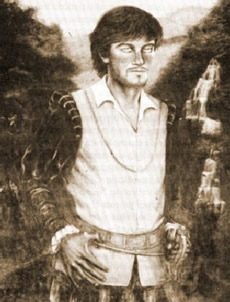Francisco de Ibarra facts for kids
Francisco de Ibarra (born 1539 – died June 3, 1575) was a brave Spanish explorer. He came from the Basque Country in Spain. Francisco de Ibarra helped found the city of Durango in Mexico. He also became the governor of a large Spanish area called Nueva Vizcaya. This area is now parts of Durango and Chihuahua states in Mexico.
Contents
Early Life and First Journey
Francisco de Ibarra was born around 1534 in a town called Eibar in Spain. When he was a young man, he traveled to Mexico. His uncle, Diego de Ibarra, was a wealthy mine owner and helped finance Francisco's first big trip.
In 1554, Francisco led an expedition to explore areas northwest of Zacatecas. He noticed silver in the area of what is now Fresnillo. However, he continued his journey. He went on to found towns like San Martín and Avino. The silver mines in these towns made him a rich mine owner himself. A Spanish historian named Baltasar Obregón wrote about Ibarra's journey to Zacatecas.
Exploring and Founding Nueva Vizcaya
Searching for the Golden City
In 1562, Ibarra led another expedition. He wanted to go even deeper into northwest Mexico. He was especially looking for a famous golden city called Copala, also known as Cibola. This city was a myth, and he did not find it.
Establishing Nueva Vizcaya
Even though he didn't find the golden city, Ibarra explored and took control of the area that is now the Mexican state of Durango. Because of his efforts, he was made governor of a new Spanish province. This province was named Nueva Vizcaya (which means New Biscay) in 1562. The very next year, in 1563, he founded the city of Durango. This city became the capital of Nueva Vizcaya.
Discovering Silver in Sinaloa
In 1564, Ibarra heard rumors of more rich mineral deposits. He crossed the Sierra Madre Occidental mountains to conquer what is now southern Sinaloa. Prospectors working with him found new silver veins in this territory. In 1565, de Ibarra founded the towns of Copala and Pánuco (Sinaloa) in this silver-rich region.
Expanding North to Chihuahua
Soldiers working for Ibarra continued to explore north from Durango in 1567. They founded the town of Santa Bárbara in what is now Chihuahua. They did this to mine the silver they discovered there.
Later Life and Death
Francisco de Ibarra died on June 3, 1575. He passed away in Pánuco, Sinaloa, which was one of the silver-mining cities he had founded.
See also
 In Spanish: Francisco de Ibarra (explorador español) para niños
In Spanish: Francisco de Ibarra (explorador español) para niños


